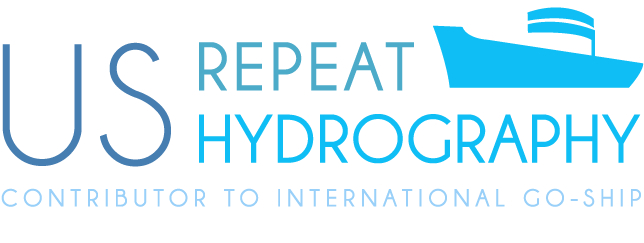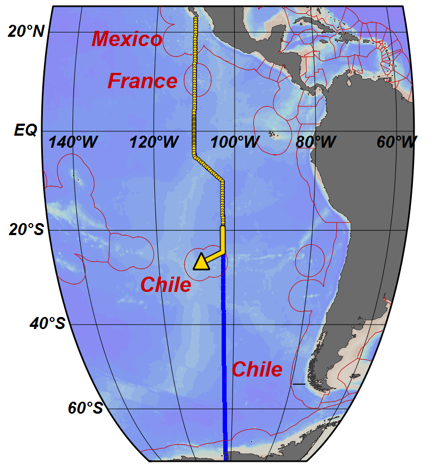
04 January 2017
 A map of our section with the yellow arrow highlighting what we’ve done this week. The thin black line at ~54°S shows the section of the Chilean EEZ where we are approved to conduct research.
A map of our section with the yellow arrow highlighting what we’ve done this week. The thin black line at ~54°S shows the section of the Chilean EEZ where we are approved to conduct research.Leg 1 came to an abrupt end one day early after an unexpected Chilean clearance problem. As noted in the previous weekly update, the Chilean clearance was expected to be granted at the last minute and allow us to proceed with our work in the EEZ surrounding Easter Island and the Island of Sala y Gomez. The problem came when the clearance documents that we received made no mention of the work we intended to do in that EEZ. Instead, the documents only approved work to be done at a later date on the approach to Punta Arenas (in a rectangle that looks like a thin black line on the map above). Fortunately, our planned stations are on the edge of the Easter Island EEZ, so we have the option of shifting the stations to international waters to the east (for a shift of up to 1 1/3° east). Rather than implementing this plan immediately, we decided it would be better to preserve sea time for leg 2 and transit to port 1 day early. We'd hoped we'd be able to resolve the confusion before leg 2 began. Unfortunately, it looks unlikely that our clearance will be able to be reviewed in time despite valiant efforts from Captain Kamphaus and our teams from the laboratories on land. It is therefore likely that these stations will need to be shifted east when they are occupied on leg 2. This is not an ideal outcome, but it is significantly better than skipping the stations.
I don't yet know why the EEZ was omitted from the approval, and I hope and expect the answer will become clear in time. The only thing I have been able to verify so far is that we did indeed request permission for the stations in the EEZ on the documents we submitted.
We arrived on the 23rd, and the Brown departed for leg 2 on the 30th. Our time in port was put to excellent use. In addition to doing wrap-up work for leg 1, prep-work for leg 2, and spending time briefing our leg 2 replacements (for those of us not staying on), our teams also got a much needed and well-earned break. There was hiking over volcanic rock and through empty lava tubes, diving and snorkeling in waters with unmatched visibility overlying gorgeous reefs, visiting the archaeological treasures of Easter Island, enjoying the food and hospitality of the locals, and finding new and creative ways to get sunburned. The time in port also allowed us to fly in replacement equipment for the vessel and a few extra personnel. Leg 2 has 28 science personnel (including our Chilean Observer) and another backup CTD unit thanks to hard work by Kristy McTaggart arranging a speedy shipment. My understanding is that the aft winch is still not holding weight despite continued troubleshooting, and that the plan is to proceed with the forward winch.
 A few panoramas from Easter Island: Sunrise over the island on the first day.
A few panoramas from Easter Island: Sunrise over the island on the first day.  Cliffs of volcanic rock plummeting into the bluest waters I've ever seen.
Cliffs of volcanic rock plummeting into the bluest waters I've ever seen.  Rano Raraku, the quarry from which the Easter Island statues were carved.
Rano Raraku, the quarry from which the Easter Island statues were carved. A few scientists looking on the statues at Tongariki.
A few scientists looking on the statues at Tongariki.I am immensely thankful for the dedication of the people on leg 1. By the hard work and good will of the science team we overcame repeated port delays, mechanical difficulties, foreign clearance issues, missing personnel, schedule uncertainties, and many straight weeks of frenetic work. All of that was in addition to the more typical stresses of oceanographic research: long hours, no weekends, no vacations, seasickness, homesickness, limited internet, etc. The Brown's crew also deserves praise. They were there with us constantly, conducting our operations; keeping us safe, fed, and healthy; getting us where we needed to go; and generally making the project pleasant and possible. All aboard should be very proud of what was accomplished on leg 1.
Leg 2 is just now beginning. I can think of no team of scientists I'd rather have responsible for completing the second part of this project. From here out I'll take on a background role, cheering them on and wishing them luck as they work through the night overcoming the inevitable small and not-so-small challenges of research at sea.